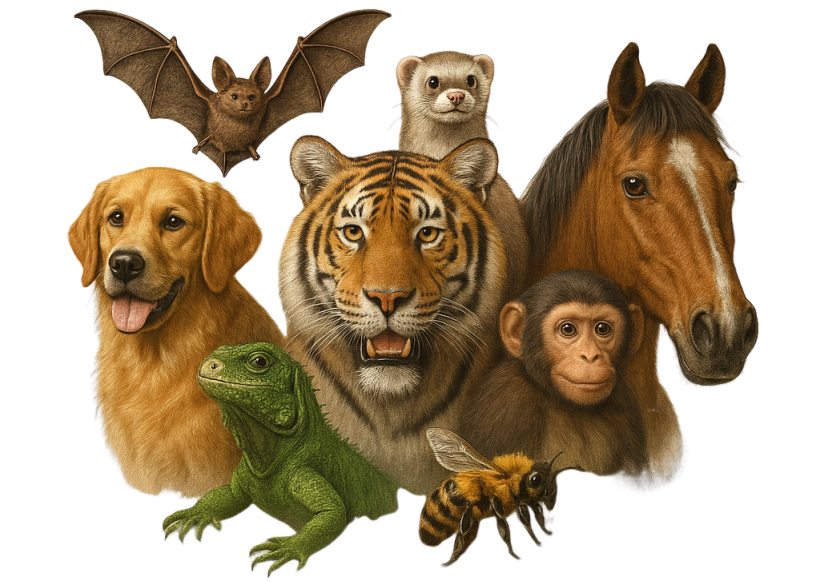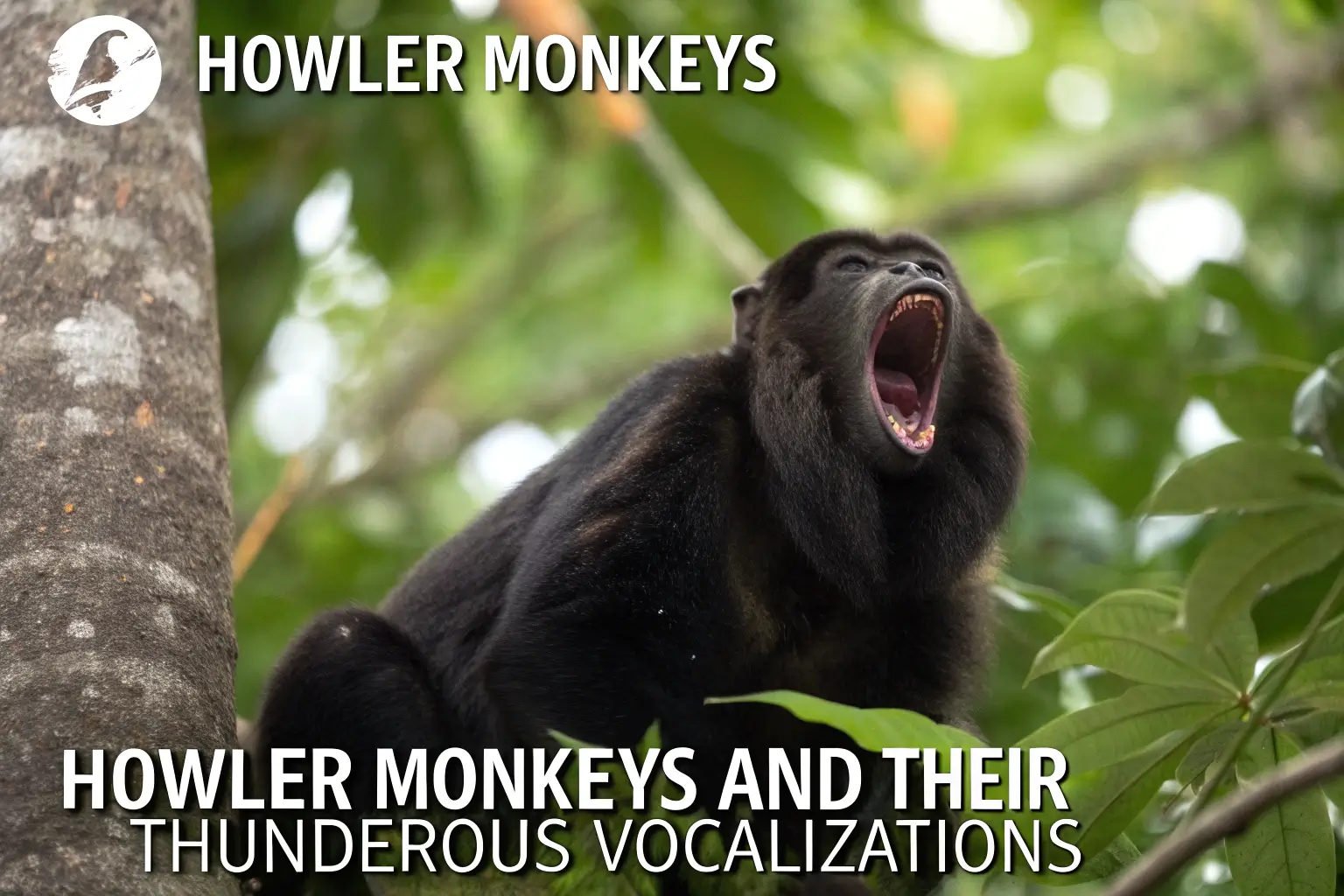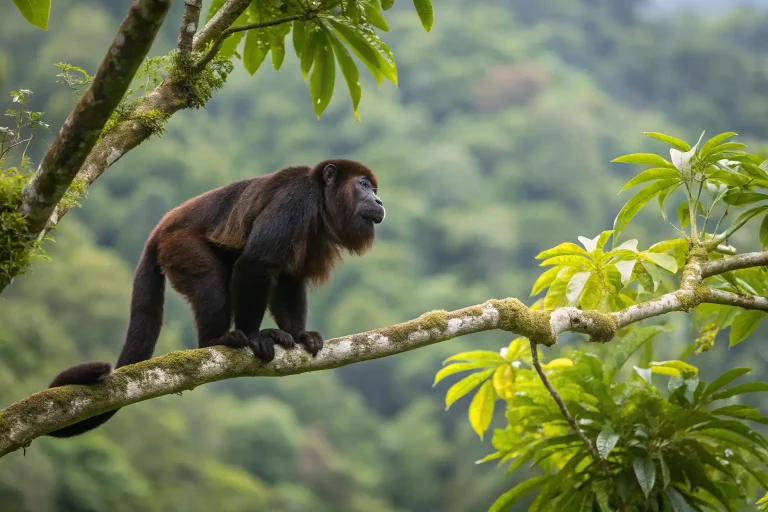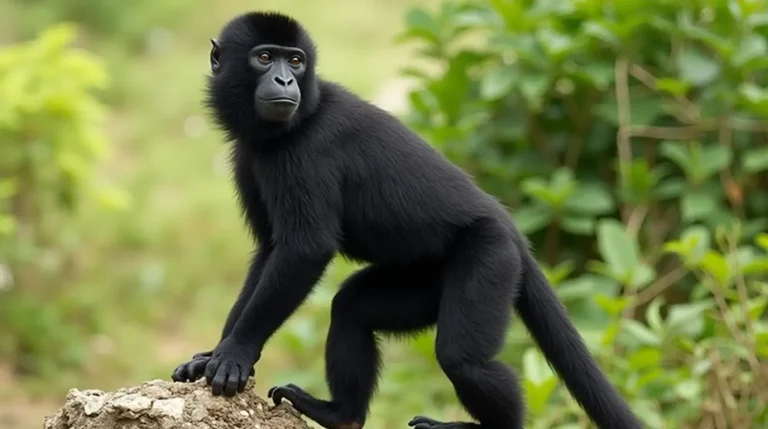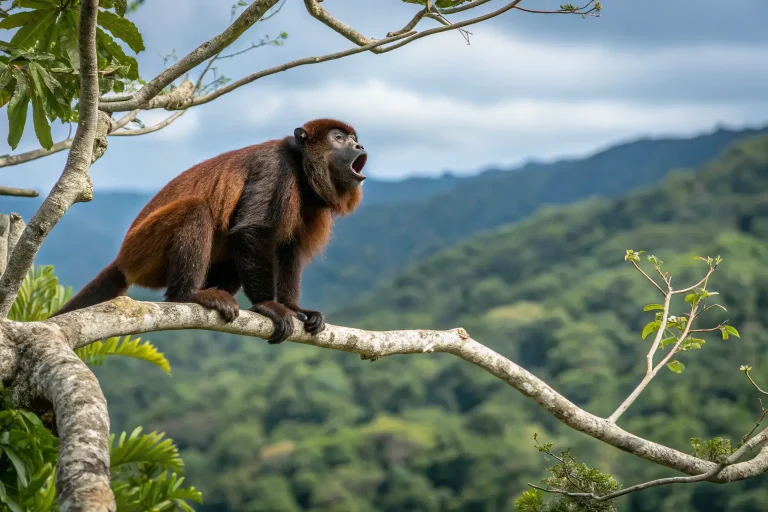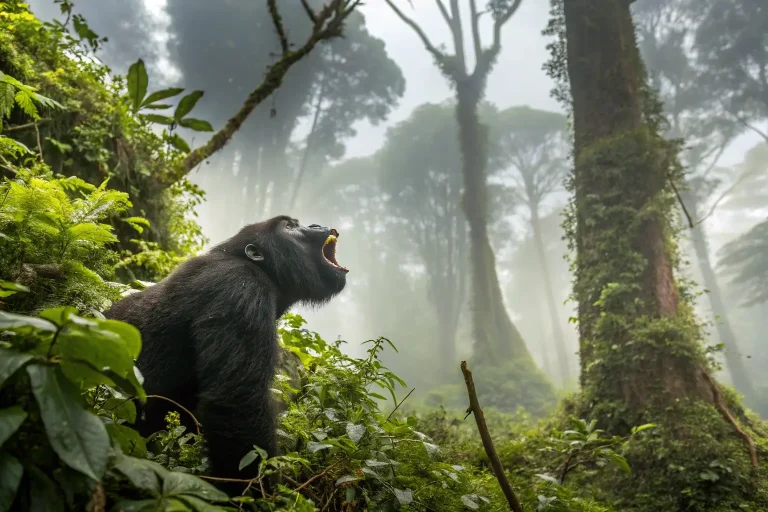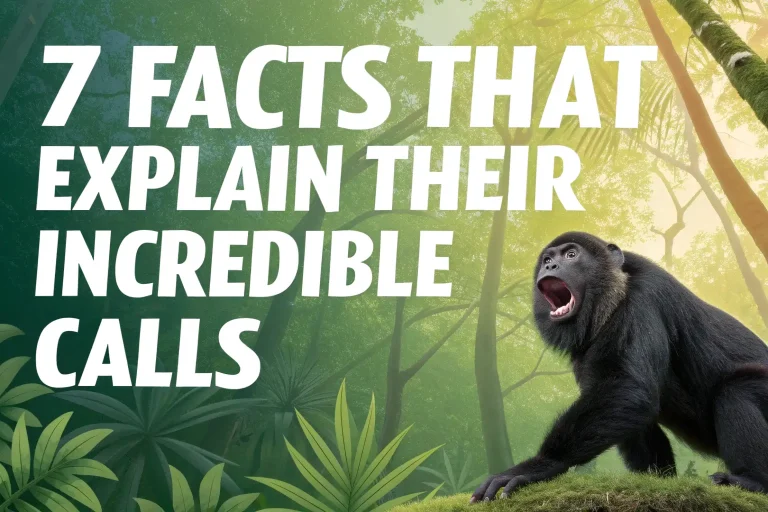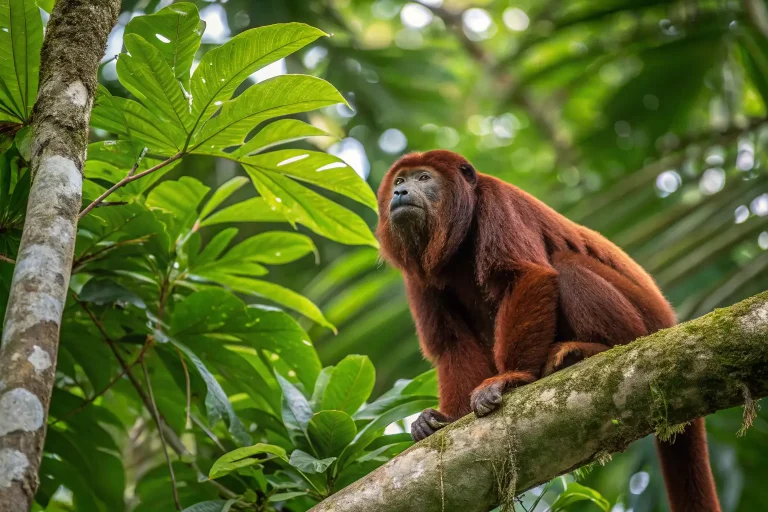Howler Monkeys Howling: 7 Facts Behind Their Thunderous Calls
Ever wondered why howler monkeys howling echoes through the forest? Uncover 7 facts behind their loud communications and wildlife behaviors. Discover their secrets!
Introduction
Deep in the rainforests of Central and South America, an otherworldly sound reverberates through the dense canopy. It’s not thunder, nor is it a jaguar – it’s the unmistakable call of howler monkeys howling, a vocalization so powerful it can be heard up to three miles away. These remarkable primates possess one of nature’s most impressive vocal performances, creating a jungle symphony that both fascinates and startles first-time rainforest visitors.
Understanding howler monkeys and their distinctive howling provides valuable insights into primate communication, social dynamics, and rainforest ecosystems. As deforestation threatens their habitats, learning about these vocal creatures becomes increasingly important for conservation efforts.
Did you know that howler monkeys have specialized throat anatomy that functions like a natural amplifier? Their unique hyoid bone – enlarged and hollow – acts as a resonating chamber, allowing them to produce sounds that reach an astonishing 140 decibels, comparable to a jet engine during takeoff!
Species Overview
Scientific Name
Howler monkeys belong to the genus Alouatta within the family Atelidae. There are currently 15 recognized species, including the well-known mantled howler (Alouatta palliata) and the red howler (Alouatta seniculus).
Physical Characteristics
Howler monkeys are among the largest New World monkeys, with males typically weighing between 15-22 pounds (7-10 kg) and females slightly smaller at 11-16 pounds (5-7 kg). Their body length ranges from 22-36 inches (56-92 cm), with an additional prehensile tail measuring 23-36 inches (58-91 cm).
Their most distinctive physical feature is the hyoid bone in their throat, which creates a resonating chamber enabling their powerful howling. This specialized adaptation is central to howler monkeys howling behavior and gives them their name.
Depending on the species, their fur coloration varies from black and brown to red and golden. All species feature a thick beard and long fur, with males typically displaying larger bodies and more prominent facial features than females.
Subspecies
The Alouatta genus encompasses diverse subspecies adapted to specific regions. For example, the mantled howler alone has seven recognized subspecies, including Alouatta palliata palliata (found in Guatemala and Honduras) and Alouatta palliata mexicana (native to Mexico). Each subspecies shows subtle variations in size, coloration, and habitat preferences while maintaining the characteristic howling ability that defines the genus.
Habitat and Distribution
Natural Habitat
Howler monkeys are quintessential arboreal creatures, spending nearly their entire lives in the upper canopy of tropical and subtropical forests. They prefer mature forests with tall trees and continuous canopy coverage, though some species have adapted to fragmented forest patches and secondary growth forests.
These primates rarely descend to the ground, living predominantly in the middle and upper forest layers where they find both food and protection from predators. Howler monkeys howling often occurs from these elevated positions, allowing their calls to travel remarkable distances across their forest home.
Geographic Range
Howler monkeys are exclusively found throughout Central and South America, from Mexico to northern Argentina. Different species occupy distinct geographic ranges:
- The mantled howler inhabits regions from southern Mexico through Central America to Colombia and Ecuador
- Black howlers are found in Brazil, Paraguay, Bolivia, and Argentina
- Red howlers populate Venezuela, Colombia, Ecuador, Brazil, and the Guianas
- Brown howlers are native to Brazil and Argentina
Their distribution is closely tied to the presence of suitable forest habitats, with population densities highest in protected rainforest areas.
Adaptations
Beyond their remarkable vocal adaptations, howler monkeys have evolved numerous traits that help them thrive in their arboreal lifestyle. Their prehensile tails function essentially as a fifth limb, providing stability and support when moving through the canopy. The undersides of their tails have specialized tactile pads with unique fingerprint-like ridges that enhance grip.
Their largely leaf-based diet required the evolution of specialized molars for grinding tough vegetation and an enlarged cecum (part of the large intestine) containing bacteria that break down cellulose. This adaptation allows them to extract sufficient nutrition from leaves, which are abundant but low in calories.
When howler monkeys howling occurs during territorial displays, their powerful vocalizations represent a crucial adaptation that minimizes physical confrontation, conserving energy in their nutritionally challenging environment.
Diet and Feeding Habits
What They Eat
Howler monkeys are primarily folivores (leaf-eaters), with leaves constituting 50-75% of their diet depending on the species and season. They prefer young, tender leaves with higher protein content and fewer toxins than mature foliage. Their diet also includes:
- Fruits (15-30% of diet), especially when seasonally abundant
- Flowers (5-10%), which provide additional nutrients
- Nuts and seeds (occasional consumption)
- Bark and stems (during food scarcity)
This flexible feeding strategy allows them to survive in various forest types while maintaining their primarily vegetarian lifestyle.
Foraging Behavior
Howler monkeys typically feed in the early morning and late afternoon, avoiding the intense midday heat. A troop moves methodically through its territory, with howler monkeys howling sometimes signaling the discovery of rich food sources or establishing feeding priority.
Their feeding pattern typically involves:
- Waking at dawn and feeding actively for 1-2 hours
- Resting during the hottest parts of the day
- Resuming feeding in the late afternoon
- Settling into sleeping trees before dusk
This energy-conserving strategy helps them subsist on their relatively low-calorie diet. Interestingly, howlers spend up to 80% of their day either feeding or resting.
Dietary Needs
The howler monkey’s leaf-heavy diet presents significant nutritional challenges. Leaves contain cellulose, which mammals cannot digest without specialized adaptations. Howlers have evolved a complex digestive system with an enlarged hindgut where bacterial fermentation breaks down plant material.
Their slow metabolism and sedentary lifestyle represent additional adaptations to their low-energy diet. Compared to other primates of similar size, howlers have substantially lower daily energy requirements. This efficiency is crucial, as a more active lifestyle would require more calories than their leafy diet could provide.
During seasonal shifts in food availability, howlers may increase their howling frequency to establish territorial boundaries around productive feeding areas.
Behavior and Social Structure
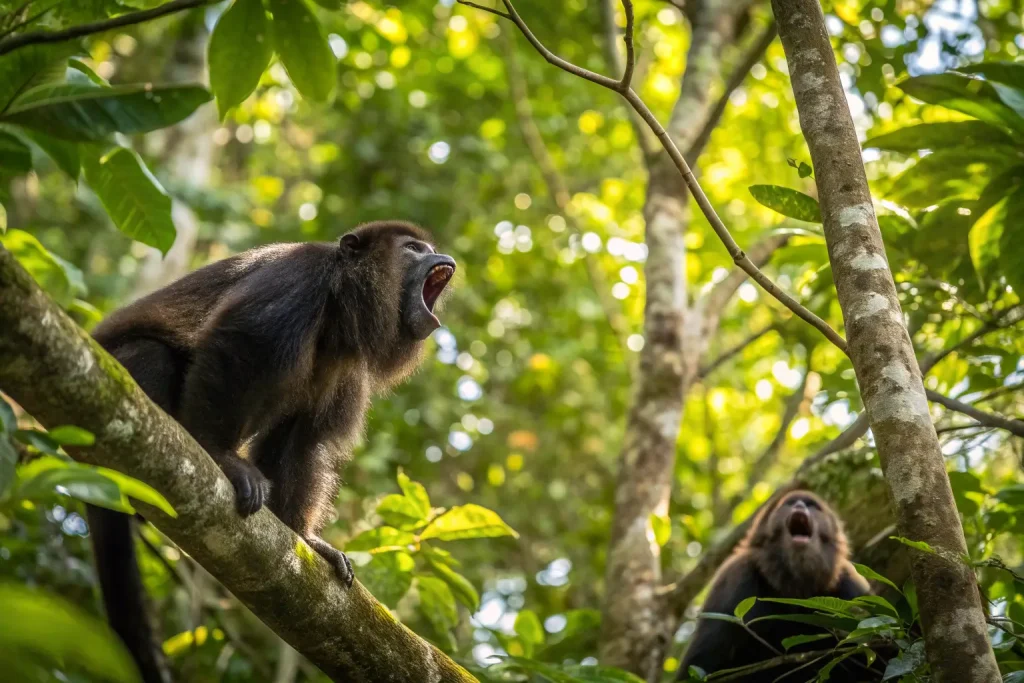
Social Behavior
Howler monkeys live in cohesive social groups typically containing 10-20 individuals, though troop size varies by species. These groups usually consist of:
- 1-3 adult males
- Several adult females
- Offspring of various ages
Their social dynamics feature a somewhat flexible dominance hierarchy, with males generally dominant over females. Unlike some primate species, however, howlers rarely engage in physical aggression within their group.
Groups maintain territories ranging from 10-60 acres (4-24 hectares), with territory size correlating to food abundance and troop size. Howler monkeys howling plays a crucial role in maintaining these territories without energy-expensive physical confrontations.
Communication
While their thunderous howls are their most famous communication method, howler monkeys employ a diverse vocal and non-vocal communication system:
The Howl – The iconic howler monkeys howling serves multiple functions:
- Territorial announcements (dawn chorus)
- Intergroup spacing
- Location signaling between separated group members
- Response to environmental disturbances
- Mate attraction
Other Vocalizations:
- Soft grunts and barks for within-group communication
- Alarm calls for predator warnings
- Contact calls when individuals become separated
Non-Vocal Communication:
- Body posturing and facial expressions
- Grooming behaviors that strengthen social bonds
- Scent marking from specialized glands
Interestingly, different species of howler monkeys have distinct howling patterns recognizable to researchers, with variations in pitch, duration, and rhythmic structure.
Mating and Reproduction
Howler monkeys typically follow a polygynous mating system, where dominant males mate with multiple females. In some species, however, multiple males may mate with females during breeding seasons.
Their reproductive characteristics include:
- Gestation period of approximately 6 months
- Usually single births (twins are rare)
- Sexual maturity reached around 3-4 years for females and 4-5 years for males
- Average lifespan of 15-20 years in the wild and up to 25 in captivity
Female howlers experience visible menstrual cycles and may initiate mating, particularly with dominant males. After birth, infants cling to their mother’s underside for the first month, gradually becoming more independent but remaining close to maternal protection for the first year.
Howler monkeys howling often intensifies during mating seasons, with males using their vocalizations to attract mates and deter competitors.
Conservation Status
Endangerment Level
The conservation status of howler monkeys varies by species, with several facing significant threats. According to the International Union for Conservation of Nature (IUCN) Red List:
- Critically Endangered: Ecuadorian mantled howler (Alouatta palliata aequatorialis)
- Endangered: Mexican howler (Alouatta palliata mexicana), Maranhão red-handed howler (Alouatta ululata)
- Vulnerable: Guatemalan black howler (Alouatta pigra)
- Near Threatened: Red howler (Alouatta seniculus)
- Least Concern: Mantled howler (Alouatta palliata), though local populations may be declining
Population trends show concerning declines across multiple species, with some having lost more than 60% of their populations over three generations.
Threats
Howler monkeys face several significant threats that impact both their populations and their iconic howling:
Habitat Loss – Deforestation for agriculture, cattle ranching, and urban development represents the most severe threat, with some regions losing over 80% of original forest cover.
Fragmentation – When forests are divided by roads or development, isolated howler populations face genetic bottlenecks and limited resources.
Hunting – Though less targeted than some primates, howlers are sometimes hunted for bushmeat or the illegal pet trade.
Disease – Yellow fever outbreaks have decimated some populations, particularly in Brazil and Argentina.
Climate Change – Altering seasonal patterns disrupts fruiting cycles and leaf production that howlers depend upon.
As forest patches shrink, the distinctive sound of howler monkeys howling disappears from regions where they once flourished.
Conservation Efforts
Multiple initiatives are underway to protect howler monkeys and their habitats:
- Protected area establishment and expansion in key howler habitats
- Reforestation projects and corridor creation connecting fragmented forests
- Community-based conservation programs involving local stakeholders
- Captive breeding programs for the most endangered species
- Research monitoring population health and howler monkeys howling patterns as indicators of group size and distribution
Organizations like the Wildlife Conservation Society and Proyecto Tití work specifically on howler monkey conservation through research, habitat protection, and public education. Several eco-tourism initiatives have also created economic incentives for local communities to protect forests where howlers live.
Interesting Facts About Howler Monkeys Howling
Nature’s Loudest Land Animal – Howler monkeys produce the loudest sound of any land animal, with calls reaching up to 140 decibels. For comparison, a rock concert typically reaches about 115 decibels, and hearing damage can occur above 85 decibels with prolonged exposure.
Morning Routine – Howler troops typically begin their day with a dawn chorus of howling, often triggered by the first light. This synchronized vocalization helps establish their presence and territorial boundaries before the day’s activities begin.
Amplification Anatomy – Their specialized U-shaped hyoid bone acts like a built-in megaphone. This unique adaptation helps create the resonating chamber that amplifies their calls to their impressive volume. The hyoid is approximately 25% larger in males than females, explaining why male howls are deeper and louder.
Energy-Saving Strategy – Rather than physically fighting rival groups, howler monkeys howling serves as a low-energy method of conflict resolution. By vocalizing their presence and strength, groups can establish boundaries without risking injury or expending precious calories.
Weather Forecasters – Local indigenous communities in parts of Central America have traditionally used howler monkey vocalizations as weather predictors. Increased howling activity sometimes precedes storm systems, leading to the belief that howlers can sense approaching weather changes.
Solar Triggers – Researchers have observed that solar events like eclipses can trigger synchronized howling across multiple troops, suggesting these primates are highly attuned to subtle environmental changes.
Individual Voices – Each howler monkey has a slightly unique vocal “signature” recognizable to other members of their troop. This individual variation allows group members to identify specific individuals by their calls, similar to how humans recognize familiar voices.
Tips for Observing Howler Monkeys in the Wild
While howler monkeys aren’t kept as pets (and shouldn’t be due to their wild nature and specialized needs), many wildlife enthusiasts seek to observe them in their natural habitat. If you’re planning a trip to experience howler monkeys howling firsthand:
Best Viewing Locations:
- Corcovado National Park, Costa Rica
- Tikal National Park, Guatemala
- Cockscomb Basin Wildlife Sanctuary, Belize
- Monkey Island, Panama
- Amazon Basin ecological reserves in Brazil and Peru
Timing Your Visit:
- Dawn and dusk offer the highest chances of hearing howler monkeys howling
- Dry season (typically December-May in most of their range) provides better visibility as canopy foliage thins
- Scheduling a multi-day stay increases your chances of hearing their impressive vocalizations
Observation Etiquette:
- Maintain at least 15-20 meters distance from troops
- Never feed wild howlers, as human food can cause serious health problems
- Keep voices low to avoid disturbing natural behaviors
- Follow guide instructions in protected areas
What to Bring:
- Binoculars (8×42 or 10×42 are ideal for canopy viewing)
- Camera with zoom lens
- Rain gear (even in dry season, tropical forests can experience sudden showers)
- Insect repellent
- Field guide to local primates
Remember that sustainable ecotourism supports conservation efforts protecting howler monkeys and their forest habitats for future generations.
Role in the Ecosystem
Ecological Importance
Howler monkeys serve as keystone species in neotropical forest ecosystems, fulfilling several critical ecological functions:
Seed Dispersal – Though primarily folivorous, howlers consume significant amounts of fruit when available. Seeds pass through their digestive systems and are deposited throughout their territory, complete with natural fertilizer. Some plant species show improved germination rates after passing through a howler’s digestive tract.
Forest Regeneration – Their seed dispersal activities directly contribute to forest regeneration and plant diversity maintenance. A single howler troop can disperse thousands of seeds from dozens of plant species annually.
Canopy Engineering – Their selective feeding habits influence canopy structure and composition. Preferred feeding trees may exhibit different branching patterns and leaf production in areas with howler populations.
Food Web Participation – Howlers serve as prey for large raptors, felids (like jaguars and ocelots), and large snakes. Howler monkeys howling often alerts other forest animals to potential predator presence.
Indicator Species – Their sensitivity to habitat quality makes them valuable indicators of forest health. The presence of howlers typically signals a functioning forest ecosystem.
Impact of Decline
The loss of howler monkey populations creates cascading effects throughout tropical ecosystems:
- Reduced seed dispersal leads to decreased forest regeneration and lower plant diversity
- Altered forest composition as certain plant species dependent on primate dispersal decline
- Disruption in predator-prey relationships affecting multiple trophic levels
- Loss of the characteristic howler monkeys howling, which forms part of the acoustic ecology of healthy forests
Research in forest fragments where howlers have disappeared shows measurable differences in plant community composition and regeneration rates compared to similar forests where howler populations remain intact.
Conclusion
The iconic sound of howler monkeys howling represents far more than an impressive natural curiosity – it’s a vital communication system evolved over millions of years, perfectly adapted to their forest lifestyle and nutritional constraints. These remarkable primates, with their specialized anatomy and complex social behaviors, exemplify evolutionary adaptation in action.
As we’ve discovered, their thunderous calls serve multiple purposes: establishing territories, attracting mates, maintaining group cohesion, and avoiding physical confrontation. The various facts behind their howling reveal a sophisticated survival strategy finely tuned to tropical forest environments.
Yet the future of these vocal forest dwellers remains uncertain as habitat loss continues across their range. The silencing of howler monkeys in deforested regions represents not just the loss of a species but the unraveling of complex ecological interactions built over evolutionary time.
By supporting conservation initiatives, sustainable ecotourism, and protected area expansion, we can help ensure that future generations will still experience the awe-inspiring sound of howler monkeys howling through intact tropical forests. Their resonant calls aren’t just a natural wonder – they’re the voice of healthy, functioning ecosystems that benefit countless species, including our own.
Frequently Asked Questions
How far can you hear a howler monkey’s call?
Howler monkeys howling can be heard up to 3 miles (5 kilometers) through dense forest. Their vocalization is the loudest of any land animal, reaching volumes of approximately 140 decibels at close range – louder than a typical rock concert and just below the pain threshold for human hearing.
Why do howler monkeys howl?
Howler monkeys howl for several key reasons: to announce territorial boundaries to neighboring groups, to coordinate group movements, to respond to potential threats, to attract mates during breeding season, and to communicate with distant troop members. Dawn howling sessions help reestablish territory boundaries each day without physical confrontation.
Are howler monkeys dangerous to humans?
No, howler monkeys are not dangerous to humans. Unlike some larger primate species, howlers are generally shy and avoid human contact. They’re primarily folivorous (leaf-eaters) with relatively sedentary lifestyles and rarely display aggression toward humans. Their impressive howling may sound intimidating but serves as communication rather than a threat display.
What time of day do howler monkeys typically howl?
Howler monkeys are most vocal at dawn and dusk, with their “dawn chorus” being particularly reliable. The early morning howling session typically begins shortly before or during sunrise and may last 30-60 minutes. Additional howling occurs throughout the day in response to disturbances, during intergroup encounters, or before rainfall.
How many species of howler monkeys exist?
Scientists currently recognize 15 distinct species of howler monkeys within the genus Alouatta. These species vary in size, coloration, geographic distribution, and subtle differences in their howling patterns. All species share the distinctive specialized hyoid bone that enables their remarkable vocalizations.
Do female howler monkeys howl as well as males?
Yes, female howler monkeys do howl, but their vocalizations differ from males in volume and frequency. Males produce louder, deeper howls due to their larger hyoid bones and throat anatomy. Females typically join in group howling sessions but at higher pitches and lower volumes than dominant males, creating the chorus effect heard in howler monkey troops.
What threats do howler monkeys face in the wild?
The primary threats to howler monkey populations include habitat destruction through deforestation, forest fragmentation that isolates populations, hunting (though less targeted than some primates), disease outbreaks (particularly yellow fever), and climate change impacts on their forest habitats. These combined pressures have led to several howler species being classified as endangered.
